Entries in Canadian Kite News (4)
Excellent "Make A Kite" Video from the Hila Outdoor Centre
Carol and Wayne Campbell are owners of the Hila Outdoor Centre on the Ottawa River in Ontario, Canada. This twelve acre facility recently celebrated 25 years of science and nature education. The Hila Outdoor Centre has an excellent reputation for strong educational programs in the sciences.
One of the most innovative aspects of the Hila Centre's work is the outreach and followup program that Carol and Wayne employ using videos to support teachers, parents and students in learning.
Their video on making a kite is one of the best, short educational videos to assist teachers with some of the principles of kite flight. In addition, the step by step procedure for making a 'sled kite' is a sure way to achieve success with a classroom program in kite building. The kite that the Hila Outdoor Centre video features is the 'sled' kite. It is a simple to make, yet sure to fly kite that is excellent for educational purposes.
Carol and Wayne's work was featured in a recent technology in education blog on the prestigious Edutopia website.
If you need additional information about using kites in the classroom, please contact me.
Silver Dart Replica Flies Into History Books
In December 1908 the Aerial Experiment Association completed the construction of Aerodrome 4 - the Silver Dart, in Hammondsport NY at the factory of Glenn H. Curtiss. The Silver Dart, the final airplane produced by the AEA, was test flown in Hammondsport in late December 1908 by chief designer Douglas McCurdy and by engine manufacturer Glenn Curtiss.
Curtiss had designed and built the earlier June Bug (Aerodrome 3) and flown it successfully for over one kilometre on July 4, 1908 to win the Scientific American Trophy for the first publicly witnessed flight of one kilometre in length.
Building on the highly publicized success of the June Bug, the Silver Dart incorporated all of the accumulated knowledge and best thinking of its designers.
Silver Dart being towed onto the ice for flight - Feb. 23, 1909.
After the successful trial flights of the Silver Dart in Hammondsport, the aerodrome was dismantled and shipped to Baddeck Nova Scotia where it flew off the ice on Bras d'or Lake on February 23, 1909. That flight was the first flight in Canada and the first in the British empire. It was truly an amazing accomplishment in the history of Canadian aviation.
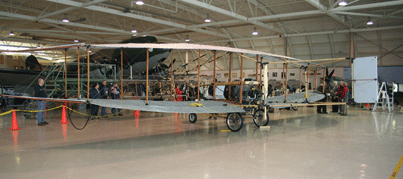
Silver Dart Replica at Canadian Warplane Heritage Museum prior to test flights, Feb. 6, 2009
In January of 2009, just one month over 100 years later, the modern aviation group AEA 2005, Inc., comprised of twenty-five historic flight volunteers from Welland, Ontario, completed a full scale replica of the original machine in a hangar of the Russell Aviation Group in Niagara Falls. Working from a set of original plans, the dedicated AEA 2005 crew worked for over five years to bring their dream to reality. It is a story of tremendous love for aviation and Canada's history.
Essentially the only difference between the replica and the original Silver Dart is the inclusion of foot controls, disc brakes, some basic instruments and the use of a 1947 aircraft engine of similar horsepower to the original Curtiss engine.
After completion in Niagara Falls, the plane was disassembled and shipped to the Canadian Warplane Heritage Museum in Hamilton, Ontario to be close to test runways at the Hamilton International Airport.
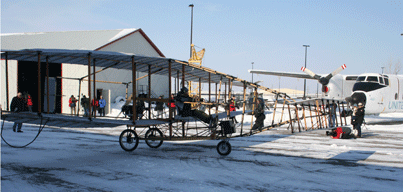
Silver Dart, with Bjarni Tryggvason as pilot, taxis for test flight, Feb. 6, 2009
On February 6, 2009 beginning at approximately 1:30 p.m. the Silver Dart replica, Canadian airplane C-IIGY, flew six brief but highly successful flights to demonstrate its airworthiness.
Former Canadian Astronaut Bjarni Tryggvason was at the controls and lifted the Silver Dart off with ease. His landings on each occasion were feather light. The first flight, on Runway 24 heading South-West, was over 3000 feet in length at a maximum altitude of three metres and lasted 50 seconds. Final touchdown occurred at 2:40 EST (19:40 Zulu). On the sixth and final flight of the afteroon the Silver Dart flew over 5,000 feet covering much of the 6,000 foot runway.
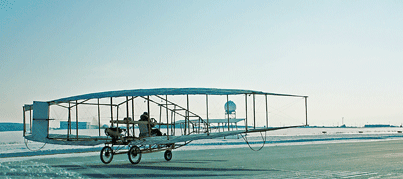
Silver Dart nears take off speed on main runway at Hamilton Airport, Feb. 6, 2009
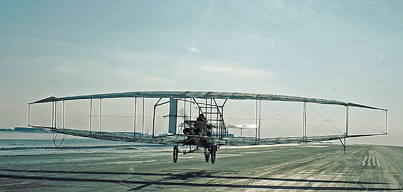
Silver Dart airborne on first flight of the day, Feb. 6, 2009. Six flights were completed.
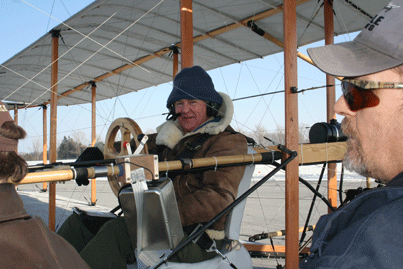
Refueling the Silver Dart between flights. Pilot Bjarni Tryggvason smiles,
pleased with the handling of the aerodrome, as he confers with the flight support crew.
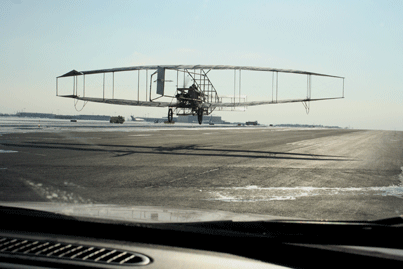
The Silver Dart at peak altitude on sixth and longest flight, Feb. 6, 2009.
The Silver Dart will now be disassembled and shipped to Baddeck Nova Scotia for the Centennary Celebrations of the flight of the original Silver Dart. On February 23, 2009, exactly one hundred years after Douglas McCurdy flew the Dart over Bras d'or Lake in a flight witnessed by Alexander Graham Bell and his wife Mabel, the other members of the AEA (Curtiss and Casey Baldwin) and hundreds of townsfolk from Baddeck, the Silver Dart replica will re-create history.
I was honoured to be a witness to this historic event by being present at the test flights of the Silver Dart replica on February 6, 2009. The hangar images of the Silver Dart and the Dart taxiing were taken at the Canadian Warplane Heritage Museum in Hamilton, Ontario. The three still images of the flight record the Silver Dart at high speed taxi and in flight on Runway 24 of the adjoining Hamilton International Airport. I took these images though the windshield of the official Hamilton International Airport escort vehicle following about 30 metres behind the Silver Dart travelling at 32 kilometres per hour . The image of Bjarni Tryggvasson conferencing with the flight support crew was taken during a refueling break on Runway 24.
Two videos showing the flight from dramatic points of view were taken by my close kiting friends Jim Anes and Carlos Simoes who also had special access to the flight.
The Jim Anes video shows the Silver Dart as it flies from right to left down the main runway. It is an amazing visual record of the fifth flight.
The Carlos Simoes video shows the Silver Dart from inside the other escort vehicle on the runway. This vehicle was driven by Doug Jermyn, head of the AEA 2005 Group that built the replica. On this video you hear the voice of Doug Jermyn calling the fifth flight as it happens. Background radio dialogue is from the Hamilton tower to the escort vehicles and an airplane that is circling waiting to land after the Dart's test flight. This is a dramatic video of the flight from just behind the aircraft.
Slide Show of the Flight Trials and Events of the Day:
Carlos Simoes has posted a complete slide show of the events of the day. Starting with the Silver Dart in the hangar early in the morning of Feb 6, 2009, the show takes you through the day with both slides and videos of each of the six flights. The slide show ends with the news media scrum and hangar celebration following the flights.
Links to News Media Coverage of the Event:
- Toronto Star: One Small Step for Aviation Buffs
- CBC.ca: Silver Dart Replica Flies at Hamilton Airport
- CTV.ca: Ex-astronaut flies replica Silver Dart
- CKCO-TV: Aviation history soars over Hamilton
- Hamilton Spectator: Magnificent Flying Machine
- Hamilton Spectator: Video - Silver Dart Makes Historic Flight Again
- Hamilton Spectator:
- Toronto Sun: Winging Into History
- Globe and Mail: Modern Silver Dart replicates history - for a few metres
- Canadian Press: Modern day version Silver Dart makes successful test run; next stop Baddeck, N.S.
- London Free Press: UWO prof achieves flight of a lifetime a full century later
- Welland Tribune: Wellander on Cloud 9 After Silver Dart Flight
- Brantford Expositor: Bell's dream taking flight again
- Aviation.ca: The Silver Dart Soars in Ontario
- AVweb.com: Silver Dart Replica Flies in Canada
The events that will take place in Baddeck Nova Scotia around the February 23, 2009 flight to mark the 100th Anniversary of the original Silver Dart flight can be found on the site of the Flight of the Silver Dart Centennial Celebration.
Details of the amazing group of builders, known as the AEA 2005 Inc., who recreated the Silver Dart are found on their web site dedicated to the Silver Dart project. This site is a detailed and very interesting account of their labour of love.
Finally, special thanks for our coverage of this event must go to Doug Jermyn and his wife Carol Harding who accorded Best-Breezes and the Historic Kiters Group incredible access to the Silver Dart during construction and on test flight day. Thank you Doug, Carol, Jack Minor, Ray Larsen, Don Feduck, James Griffith, Bjarni Tryggvason and Gerry Bettridge (Russell Aviation Group) for all you did to accommodate our coverage of this event.
________________
Other related reference sites:
- Glenn H. Curtiss Museum. Located in Hammondsport NY this museum is an outstanding site to visit for information on Glenn Curtiss, the Aerial Experiment Association and early flight.
- Parks Canada - Alexander Graham Bell National Historic Site. Located in Baddeck NS this museum is operated by Parks Canada and is dedicated to communicating the story of Alexander Graham Bell's wide ranging interests and inventive work, much of it undertaken right in Baddeck, Nova Scotia.
Story and photos by Bob White (Member Historical Research Writers Association).
Bell's Tetrahedral Kite - Centennial Celebrations
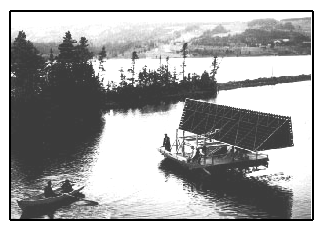 One hundred years ago, on December 6, 2007, Alexander Graham Bell launched his largest tetrahedral kite, the Cygnet II, over the waters of Bras d'Or lake in Cape Breton, Nova Scotia. Towed behind a steam powered boat and carrying Lieut. Thomas Selfridge as passenger and to some degree pilot, the Cygnet was a milestone in the history of the development of flight and one of the most significant events in Canadian kite history.
One hundred years ago, on December 6, 2007, Alexander Graham Bell launched his largest tetrahedral kite, the Cygnet II, over the waters of Bras d'Or lake in Cape Breton, Nova Scotia. Towed behind a steam powered boat and carrying Lieut. Thomas Selfridge as passenger and to some degree pilot, the Cygnet was a milestone in the history of the development of flight and one of the most significant events in Canadian kite history.
A great deal of attention is being paid to the tetrahedral kites of Dr. Bell during this centennial celebration year marking the historic flight of the huge Cygnet. It certainly is a time to pause and remember the amazing ingenuity of the era as humans searched for the best ways to lift people into the sky in a safe and controlled manner.
Bell's intention was to use the inherently strong tetrahedron as a building block for an 'aerodrome' (aircraft) that would eventually be powered by a gasoline engine and achieve independent flight under the control of a pilot.
The Halifax Chronicle Herald ran a feature story on the work of Bell's Aerial Experiment Association, a group of five engineer-scientist fellows. The group was funded with a $30,000 investment provided by Mabel Bell, Dr. Bell's wife, who acted as the group's Secretary-Treasurer.
Uplifting dream was born century ago
Within 18 months, Bell-led group had Silver Dart in Baddeck sky
By TERA CAMUS Cape Breton BureauThe ChronicleHerald.ca October 1, 2007
BADDECK — It was 100 years ago today when it all began.
High on the hill overlooking Baddeck Bay, Alexander Graham Bell invited four men to his estate to begin working on a dream that would literally take flight 18 months later, in 1909.
Backed with $30,000 from Mr. Bell’s wealthy socialite wife Mabel, five creative minds forged a partnership known as the Aerial Experiment Association after the famous, aging inventor convinced them they could take flight in an aircraft after experimenting with large kites on and over his Baddeck estate.
"It’s amazing to think that for thousands and thousands of years, we couldn’t fly and within 18 months, bang, we’re flying among the stars," Mr. Bell’s great-grandson, Hugh Bell Muller, told The Chronicle Herald inside the Kite House where the five men constructed the aircraft.
Mr. Muller and his wife still walk on the original floorboards of that former barn, now renovated into a comfortable home, where Alec Bell, as he was known locally, worked with British immigrant Douglas McCurdy, a resident of Baddeck, and Toronto’s Casey Baldwin, both expert engineers. He also invited United States Lt. Thomas Selfridge and Glenn Curtiss, a New Yorker who built engines.
All five men lived in "the big house," better known as Beinn Bhreagh, which now is only open in summers for Mr. Bell’s direct descendants.
"In Bell’s time, he knew all the scientists," Mr. Muller said. "As a kid, he dreamed about flying while watching the birds."
The Wright Brothers, who had proved an aircraft could lift off using a catapult method, were busy in the United States trying to understand how to maintain flight.
"Bell was concerned with two things, the first was safety and the other was stability of controls to maintain a flight," Mr. Muller said. "Ms. Bell told him: ‘The five of you get an airplane in that air’ and it took 18 months to get the Silver Dart."
The first aircraft built in the Kite House in 1907 was the Cygnet, but it had no engine. It carried Selfridge for seven minutes and 51 metres and "flew beautifully" before it crashed into the water below Mr. Bell’s estate.
Moving on from the Cygnet, Bell and the five members of the AEA built four powered airplanes that were stable and reliable in flight. The culminating aircraft was the famous "Silver Dart" which was the first airplane to fly in the British Commonwealth of Nations when it lifted off the frozen waters of Bras d'Or Lake on February 23, 1909.
During this centennial celebration year of the massive Cygnet kite, a special commemorative kite fly was organized by the Canadian Kite Federation/Federation Canadienne du Cerf-Volant amd the Drachen Foundation of Seattle WA. The event was held on the Bell estate at Beinn Bhreagh overlooking Bras d'Or Lake in Baddeck, Nova Scotia on August 21, 2007.
Gary Mark of CKF/FCCV and Scott Skinner of the Drachen Foundation were instrumental in putting together the kite fly tribute to Bell's work with the Cygnet kite. More information can be found in an excerpt from the web site of the Drachen Foundation. A terrific video of interviews with Gary Mark, principal organizer of the event, and Hugh Muller, great-grandson of Alexander Bell is found on a special video clip at YouTube. Another interesting video clip is the CBC-TV Newsworld live broadcast of the event, also at YouTube.
In the autumn of 2004, CBC ran a television series entitled: The Greatest Canadian. Alexander Graham Bell was one of the featured candidates for the title of the greatest Canadian. I had the privilege of working on the production of that television show along with my good friend Gary Mark. To read about that story you can see an earlier posting in the Best-Breezes blog that detailed Bell's tetrahedral kites and see how a kite was included in the video taping for the show.
In the web site section of Best-Breezes, you can find more detailed information on Bell's Cygnet kite, the aerodromes of the Aerial Experiment Association, and a variety of other references on Bell's work with kites and aircraft. Be sure to check out the article entitled: Alexander Graham Bell: After the Telephone - Tetrahedral Kites, Airplanes and Hydrofoils.
One hundred years later the memory of Alexander Graham Bell's giant tetrahedral kites still lifts the imagination and makes the spirit soar!
Canadian Kiter Makes Kiting News!
Some of our great Canadian kiters are making kite news and this is good for Canadian kiting!
Bill Wilson of the Halifax Kitefliers recently made the pages of the on-line E-zine MAKE for his kite aerial photography and for his terrific Steady Winds kite blog.
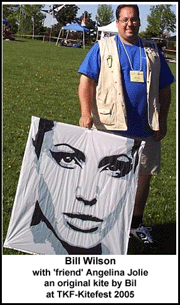 MAKE e-zine features how-to articles about nifty projects and encourages readers to try new things in creative ways. Some months ago MAKE published an article on how to build a KAP (Kite Aerial Photography) rig that attracted a lot of attention. Now, in a follow-up article, they are featuring the KAP work of Bill Wilson and his weblog. What a great tribute to Bill who is a very accomplished kite maker.
MAKE e-zine features how-to articles about nifty projects and encourages readers to try new things in creative ways. Some months ago MAKE published an article on how to build a KAP (Kite Aerial Photography) rig that attracted a lot of attention. Now, in a follow-up article, they are featuring the KAP work of Bill Wilson and his weblog. What a great tribute to Bill who is a very accomplished kite maker.
Bill always shares information and ideas as well as offering encouragement and support. He is a superb guy and one that I am glad I met through kiting.
Terrific work and good news for the Canadian kite scene!






